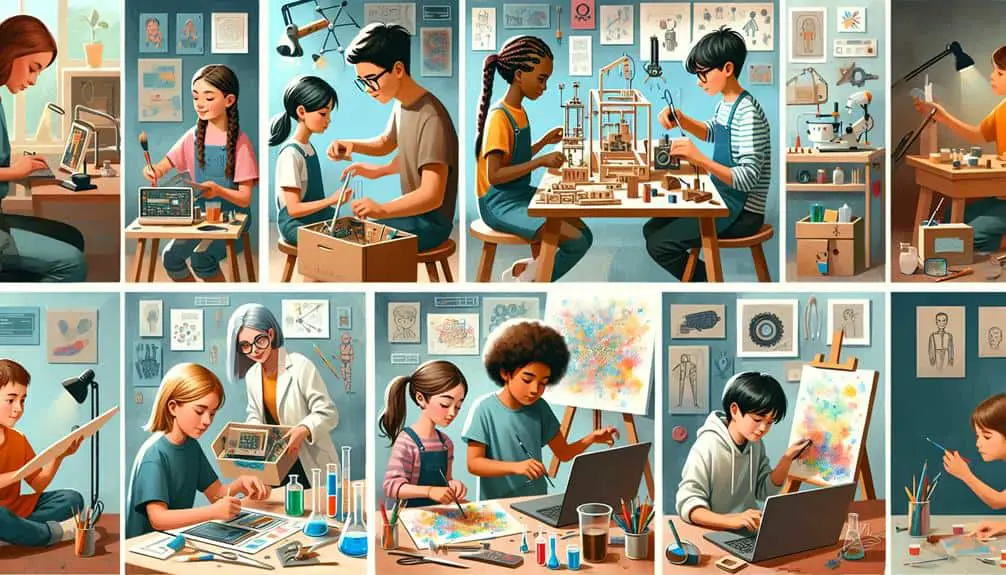Evaluating creativity and innovation in homeschool settings through thorough evaluations is essential for developing unique talents and fostering a holistic learning environment. Utilize creative expression tasks and problem-solving assessments to gauge creative skills effectively. Evaluating artistic talent and critical thinking abilities through real-world scenarios provides valuable insights. Implement rubrics, portfolios, and project-based assessments to measure creativity levels accurately. Despite challenges in quantifying and testing creativity, strategies like fostering diverse perspectives and incorporating real-world challenges can enhance the creative learning experience. Understanding the importance of evaluating creativity and innovation in homeschooling is vital for nurturing well-rounded individuals.
Key Points
- Utilize diverse creativity assessments to gauge innovative thinking skills accurately.
- Incorporate project-based tasks and portfolios for holistic evaluation of creativity.
- Tailor assessments to individual needs to enhance creativity and innovation outcomes.
- Implement peer assessments and feedback sessions for comprehensive insights into creativity.
- Foster a supportive environment that values diverse perspectives to nurture creativity effectively.
Importance of Assessing Creativity
Evaluating creativity in homeschool settings is essential for gauging the effectiveness of educational methods and fostering innovative thinking skills in students. Evaluating creative potential allows educators to tailor instruction to individual needs, enhancing the overall learning experience. By implementing various evaluation methods, such as portfolio assessments, project-based tasks, and creative problem-solving activities, homeschooling parents can gain insight into their child's unique strengths and areas for growth.
Understanding the impact of innovation on educational growth is critical in nurturing well-rounded individuals capable of adapting to an ever-changing world. By evaluating creativity, parents can track the progression of their child's critical thinking skills, communication abilities, and overall cognitive development. This process not only benefits academic performance but also cultivates essential life skills that are crucial for success in the future.
Incorporating creativity assessments into homeschool curricula provides a holistic approach to education, promoting a balance between traditional academic subjects and innovative thinking. By recognizing and nurturing creativity, parents can help their children thrive academically and personally, setting a strong foundation for future achievements.
Types of Creativity Assessments
Evaluating creativity in homeschool settings involves utilizing various methods to measure students' innovative capabilities and potential for growth. Creative expression can be assessed through tasks that require students to think outside the box, such as open-ended projects or imaginative writing assignments.
Problem-solving skills can be evaluated through scenarios that challenge students to find unique solutions to complex issues. Assessments focusing on artistic talent may involve tasks like creating original artwork or composing music, allowing students to showcase their creative abilities.
Additionally, critical thinking assessments can gauge students' ability to analyze information, make logical connections, and form well-reasoned arguments. These evaluations often involve evaluating students' responses to thought-provoking questions or real-world problems, encouraging them to demonstrate their analytical skills.
Benefits of Innovation Evaluation
Evaluating innovation in homeschool settings brings about valuable insights into students' creative potential and growth opportunities. By appraising innovation impact, educators can identify areas where students excel in generating new ideas, problem-solving, and implementing novel solutions. Understanding the creative potential of homeschool students through evaluation allows for tailored learning experiences that foster innovation and critical thinking skills.
Appraising innovation provides a holistic view of a student's ability to think outside the box, adapt to new challenges, and create unique solutions. It also helps in recognizing individual strengths and areas for improvement, guiding educators in shaping a curriculum that nurtures creativity and ingenuity.
Furthermore, innovation evaluation encourages students to explore diverse perspectives, experiment with different approaches, and embrace failure as a stepping stone to success. This process not only enhances their problem-solving skills but also equips them with the resilience and adaptability needed to thrive in an ever-evolving world.
Ultimately, by measuring innovation impact and creative potential, homeschool educators can empower students to become innovative thinkers and change-makers.
Implementing Assessment Tools
To effectively evaluate homeschool creativity and innovation, the implementation of appropriate assessment tools is vital in providing valuable insights into students' abilities. Utilizing various assessment strategies and evaluation techniques can help measure the creativity and innovation of homeschool students accurately. Performance metrics play a significant role in evaluating how well students are demonstrating their creative and innovative capabilities. By incorporating measurement tools such as rubrics, portfolios, project-based assessments, and self-assessments, educators can gain a thorough understanding of students' strengths and areas for improvement in creativity and innovation.
Evaluation strategies like divergent thinking tasks, open-ended projects, real-world problem-solving scenarios, and creative challenges can be instrumental in gauging students' creative thinking skills. Evaluation techniques such as peer assessments, teacher observations, and feedback sessions can provide additional perspectives on students' innovative abilities. By combining different performance metrics and measurement tools, homeschool educators can create a well-rounded evaluation approach that effectively captures the creativity and innovation of their students.
Challenges in Creativity Testing
Evaluating homeschool creativity and innovation through testing can present various challenges that may impact the accuracy of gauging students' abilities in these domains. When it comes to creativity testing, there are specific hurdles to overcome:
- Creativity Metrics: Quantifying creativity is complex as it often involves subjective judgment and interpretation.
- Standardized Tests: Traditional standardized tests may not effectively capture the multidimensionality of creativity and innovation.
- Subjective Evaluation: Evaluating creativity relies on subjective appraisals, which can introduce bias and inconsistency.
- Practical Exercises: While practical exercises can be beneficial, designing tasks that accurately measure creativity can be challenging.
- Interdisciplinary Nature: Creativity often spans multiple disciplines, making it difficult to create evaluations that encompass all relevant areas.
These challenges highlight the need for a thoughtful and all-encompassing approach to creativity testing in homeschool settings to guarantee accurate evaluations of students' creative and innovative capacities.
Analyzing Assessment Results
Upon completion of the creativity and innovation assessments for homeschool students, the next step involves delving into the analysis of the obtained results. Assessment analysis plays a pivotal role in understanding the levels of creativity and innovation among homeschool students.
When examining the assessment results, it's vital to delve into the various components that make up the creativity measurement. This includes evaluating not only the final scores but also the specific areas where students excelled or may need further development.
In the assessment analysis, it's crucial to take into account the different types of tasks or challenges presented to students to gauge their creative thinking abilities. By breaking down the results into manageable sections, educators and parents can pinpoint strengths and weaknesses in creativity and innovation.
This detailed analysis allows for targeted interventions and strategies to enhance creative learning experiences moving forward.
Through thorough assessment analysis, homeschool educators can gain valuable insights into how to nurture and support creativity and innovation in their students effectively. By using these results as a guide, educators can tailor their approaches to maximize the creative potential of homeschool learners.
Enhancing Creative Learning Experience
By implementing targeted interventions and strategies, homeschool educators can effectively enhance the creative learning experience for their students. To achieve this, consider the following approaches:
- Encourage Divergent Thinking: Foster a classroom environment that values diverse perspectives and encourages thinking outside the box, allowing students to explore multiple solutions.
- Incorporate Real-World Challenges: Integrate real-life problems into the curriculum to promote creativity and innovation in finding practical solutions.
- Provide Opportunities for Self-Expression: Allow students to express themselves through various mediums such as art, music, or writing to nurture their creativity.
- Promote Collaborative Projects: Encourage group projects that require teamwork and cooperation, fostering creativity through shared ideas and perspectives.
- Integrate Technology: Utilize digital tools and platforms to enhance learning experiences, enabling students to engage in innovative projects that incorporate technology.
These strategies can significantly enhance the creative learning experience, empowering students to develop critical thinking skills and creativity through engaging in creative projects and innovative curriculum.
Frequently Asked Questions
How Can Creativity Assessments Improve Parent-Child Relationships in Homeschooling?
To enhance parent-child relationships in homeschooling, utilize creativity assessments. These tools foster communication skills, problem-solving, critical thinking, and collaboration. By engaging in these assessments together, you can strengthen bonds, encourage growth, and cultivate a deeper connection.
Are There Any Potential Biases in Creativity Assessments for Homeschooled Children?
Assessment bias in homeschooling can arise due to creativity challenges not always aligning with standardized tests. Understanding potential biases can help tailor assessments to better capture the diverse ways homeschooled children express creativity.
Can Creativity Assessments Help Identify Areas of Strength for Homeschoolers?
Creativity assessments can be valuable for homeschoolers. They can pinpoint areas of strength, offering growth potential insights. With individualized feedback, homeschoolers can focus on skill development, enhancing their innovative capacities and fostering creative thinking.
What Role Do Extracurricular Activities Play in Creativity Assessment Results?
When considering homeschool creativity, extracurricular opportunities can greatly impact creativity assessment results. Parental involvement in guiding and supporting these activities can play an essential role in nurturing and showcasing a child's creative talents and skills.
How Can Creativity Assessments Be Tailored to Different Learning Styles in Homeschooling?
Tailoring creativity assessments to diverse homeschooling styles involves using customized approaches and multi-modal strategies. Providing personalized feedback guarantees that each learner's unique strengths are recognized. This fosters a more thorough evaluation process.



